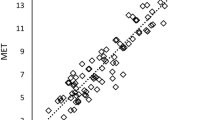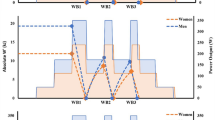Abstract
The purposes of this study were twofold. First, to evaluate the cardiorespiratory and muscle oxygenation (OXY)/blood volume (BV) responses during repetitive incremental lifting and lowering (RILL) in healthy males and females. Second, to develop a predictive equation for predicting peak aerobic power (\( \dot V \)O2peak) during RILL from the cardiorespiratory, OXY/BV and body composition variables. Fourteen males and 18 females [mean (SD) for age, height and body mass were: 29.6 (8.2) years; 1.75 (0.07) m; 78.9 (10.4) kg and 23.9 (2.1) years; 1.63 (0.06) m; 62.3 (6.3) kg, respectively] completed a RILL from floor to table height at 10 lifts/min to voluntary fatigue. Cardiorespiratory responses were measured using open circuit spirometry and hemodynamic trends were monitored bilaterally at the third lumbar vertebra via near infrared spectroscopy. Significant sex differences (p<0.05) were observed for the peak values of oxygen uptake (\( \dot V \)O2peak), ventilation rate (\( \dot V \) E), oxygen pulse, BV-max and BV-delta. Erector spinae OXY decreased systematically until \( \dot V \)O2peak was attained, while BV decreased until ~50% of \( \dot V \)O2peak and then leveled off. Stepwise regression analysis indicated that ~75% of the variance in \( \dot V \)O2peak was predicted from cardiorespiratory, hemodynamic and body composition variables, with the most important predictors for absolute and relative \( \dot V \)O2peak being \( \dot V \) E (r=0.75) and fat mass (r=−0.63) respectively. Inclusion of left side OXY/BV responses increased the predictability of the common variance in \( \dot V \)O2peak from 40% to 74%, implying that muscle hemodynamics play an important role in determining \( \dot V \)O2peak during RILL.


Similar content being viewed by others
References
American College of Sports Medicine (2001) Resource manual for guidelines for exercise testing and prescription. Lippincott Williams Wilkins, Philadelphia
Belardinelli R, Barstow T, Porsasz J (1995) Changes in skeletal muscle oxygenation during incremental exercise measured with near infrared spectroscopy. Eur J Appl Physiol 70:487–492
Bhambhani Y, Maikala R, Buckley S (1998) Muscle oxygenation during incremental arm and leg exercise in men and women. Eur J Appl Physiol 78:422–431
Bondra-Petersen F, Mørk AL, Nielsen E (1975) Local muscle blood flow and sustained isometric contractions of human arm and back muscles. Eur J Appl Physiol 34:43–50
Borg G, Noble B (1974) Perceived exertion. Exerc Sport Sci Rev 2:131–153
Canadian Society for Exercise Physiology (1996) The Canadian physical activity, fitness and lifestyle appraisal manual: CSEP'S plan for healthy active living. The Canadian Society for Exercise Physiology, Ottawa
Chance B, Dait M, Zhang C (1992) Recovery from exercise-induced saturation in the quadriceps muscles of elite competitive rowers. Am J Physiol 262:C766–C775
Commissaris DA, Toussaint HM (1996) Dissociated oxygen uptake response to an incremental intermittent repetitive lifting and lowering exercise in humans. Eur J Appl Physiol 74:264–273
Consolazio CF, Johnson RE, Pecora LJ (1963) Physiological measurements of metabolic function in Man. McGraw Hill, New York
Costes F, Prieur F, Feasson L (2001) Influence of training on NIRS muscle oxygen saturation during submaximal exercise. Med Sci Sports Exerc 33:1484–1489
Durnin JVGA, Womersley J (1974) Body fat assessed from total body density and its estimation from skinfold thickness: measurements on 481 men and women aged from 16 to 72 years. Br J Nutri 32:77–97
Fernandez JE, Marley RJ, Stubbs NB (1987) Lifting physical work capacity as a function of frequency. Proceeding of the 31st Annual Meeting of the Human Factors Society, pp 1331–1335
Grassi B, Quaresima V, Marconi C (1999) Blood lactate accumulation and muscle deoxygenation during incremental exercise. J Appl Physiol 87:348–355
Jensen BR, Jorgensen K, Hargens AR (1999) Physiological response to submaximal isometric contractions of the paravertebral muscles. Spine 24:2332–2338
Kunimune Y, Harada Y, Kabuto Y (1999) Recovery from exercise-induced desaturation in the paraspinal muscles in idiopathic scoliosis. Spine 24:2019–2024
Legg AJ (1981) Maximum acceptable repetitive lifting workloads for an 8-hour work-day using psychological and subjective rating methods. Ergonomics 24:907–916
Mancini D, Bolinger L, Li L (1994) Validation of near-infrared spectroscopy in humans. J Appl Physiol 77:2740–2745
Maronitis AB, Kovacs KM, Splittstoesser RE, Marras WS (2000) The effectiveness of whole body and localized measures of fatigue. In: Proceedings of the International Ergonomics Association XIVth Triennial Congress Human Factors and Ergonomics Society 44th Annual Meeting. International Ergonomics Association and The Human Factors and Ergonomics Society, San Diego, pp 5–91–95–94
McArdle WD, Katch FI, Katch VL (2001) Exercise physiology: energy, nutrition, and human performance. Lippincott, Williams, Wilkins, New York
McGill SM, Hughson RL, Parks K (2000) Lumbar erector spinae oxygenation during prolonged contractions: implications for prolonged work. Ergonomics 43:486–493
National Institute for Occupational Safety and Health (1981) Work practices guide for manual lifting. US Government Printing Office. DHHS Publication No. 81–122, Washington
Nindl BC, Sharp MA, Mello RP (1998) Gender comparison of peak oxygen uptake: repetitive box lifting versus treadmill running. Eur J Appl Physiol 77:112–117
Petrofsky JS, Lind AR (1978a) Comparison of metabolic and ventilatory responses of men to various lifting tasks and bicycle ergometry. J Appl Physiol 45:60–63
Petrofsky JS, Lind AR (1978b) Metabolic, cardiovascular, and respiratory factors in the development of fatigue in lifting tasks. J Appl Physiol 45:64–68
Revuelta N, Dauphin A, Kowslowski O (2000) Heart rate response to two lifting techniques. Arch Phys Med Rehabil 81:958–959
Sharp MA, Harman E, Vogol JA (1988) Maximal aerobic capacity for repetitive lifting: comparison with three standard exercise tests and modes. Eur J Appl Physiol 57:753–760
Tsuboi T, Satou T, Egawa K (1994) Spectral analysis of electromyogram in lumbar muscles: fatigue induced endurance contraction. Eur J Appl Physiol 69:361–366
van Beekvelt MC, Borghuis MS, van Engelen BG (2001) Adipose tissue thickness affects in vivo quantitative near-IR spectroscopy in human skeletal muscle. Clin Sci 101:21–28
Yoshitake Y, Ue H, Miyazaki M (2001) Assessment of lower-back muscle fatigue using electromyography, mechanomyography, and near-infrared spectroscopy. Eur J Appl Physiol 84:174–179
Acknowledgements
This research was funded by an Operating Grant from the Alberta Workers' Compensation Board and Support for the Advancement of Scholarship, University of Alberta. We would also like to thank all the subjects who volunteered to make the project a success.
Author information
Authors and Affiliations
Corresponding author
Rights and permissions
About this article
Cite this article
Kell, R.T., Bhambhani, Y. Cardiorespiratory and hemodynamic responses during repetitive incremental lifting and lowering in healthy males and females. Eur J Appl Physiol 90, 1–9 (2003). https://doi.org/10.1007/s00421-002-0776-0
Accepted:
Published:
Issue Date:
DOI: https://doi.org/10.1007/s00421-002-0776-0




